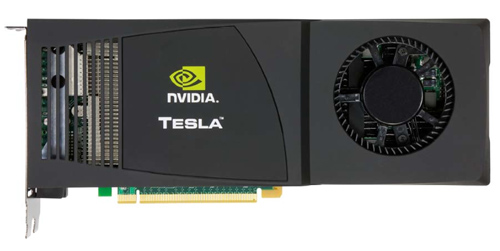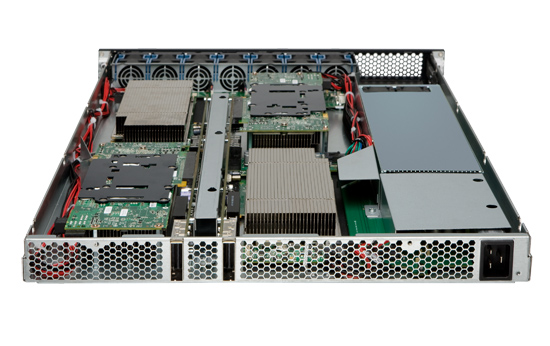NVIDIA's Fermi: Architected for Tesla, 3 Billion Transistors in 2010
by Anand Lal Shimpi on September 30, 2009 12:00 AM EST- Posted in
- GPUs
A Different Sort of Launch
Fermi will support DirectX 11 and NVIDIA believes it'll be faster than the Radeon HD 5870 in 3D games. With 3 billion transistors, it had better be. But that's the extent of what NVIDIA is willing to talk about with regards to Fermi as a gaming GPU. Sorry folks, today's launch is targeted entirely at Tesla.

A GeForce GTX 280 with 4GB of memory is the foundation for the Tesla C1060 cards
Tesla is NVIDIA's High Performance Computing (HPC) business. NVIDIA takes its consumer GPUs, equips them with a ton of memory, and sells them in personal or datacenter supercomputers called Tesla supercomputers or computing clusters. If you have an application that can run well on a GPU, the upside is tremendous.

Four of those C1060 cards in a 1U chassis make the Tesla S1070. PCIe connects the S1070 to the host server.
NVIDIA loves to cite examples of where algorithms ported to GPUs work so much better than CPUs. One such example is a seismic processing application that HESS found ran very well on NVIDIA GPUs. It migrated a cluster of 2000 servers to 32 Tesla S1070s, bringing total costs down from $8M to $400K, and total power from 1200kW down to 45kW.
| HESS Seismic Processing Example | Tesla | CPU |
| Performance | 1 | 1 |
| # of Machines | 32 Tesla S1070s | 2000 x86 servers |
| Total Cost | ~$400K | ~$8M |
| Total Power | 45kW | 1200kW |
Obviously this doesn't include the servers needed to drive the Teslas, but presumably that's not a significant cost. Either way the potential is there, it's just a matter of how many similar applications exist in the world.
According to NVIDIA, there are many more cases like this in the market. The table below shows what NVIDIA believes is the total available market in the next 18 months for these various HPC segments:
| Processor | Seismic | Supercomputing | Universities | Defence | Finance |
| GPU TAM | $300M | $200M | $150M | $250M | $230M |
These figures were calculated by looking at the algorithms used in each segment, the number of Hess-like Tesla installations that can be done, and the current budget for non-GPU based computing in those markets. If NVIDIA met its goals here, the Tesla business could be bigger than the GeForce one. There's just one problem:
As you'll soon see, many of the architectural features of Fermi are targeted specifically for Tesla markets. The same could be said about GT200, albeit to a lesser degree. Yet Tesla accounted for less than 1.3% of NVIDIA's total revenue last quarter.
Given these numbers it looks like NVIDIA is building GPUs for a world that doesn't exist. NVIDIA doesn't agree.
The Evolution of GPU Computing
When matched with the right algorithms and programming efforts, GPU computing can provide some real speedups. Much of Fermi's architecture is designed to improve performance in these HPC and other GPU compute applications.
Ever since G80, NVIDIA has been on this path to bring GPU computing to reality. I rarely get the opportunity to get a non-marketing answer out of NVIDIA, but in talking to Jonah Alben (VP of GPU Engineering) I had an unusually frank discussion.
From the outside, G80 looks to be a GPU architected for compute. Internally, NVIDIA viewed it as an opportunistic way to enable more general purpose computing on its GPUs. The transition to a unified shader architecture gave NVIDIA the chance to, relatively easily, turn G80 into more than just a GPU. NVIDIA viewed GPU computing as a future strength for the company, so G80 led a dual life. Awesome graphics chip by day, the foundation for CUDA by night.
Remember that G80 was hashed out back in 2002 - 2003. NVIDIA had some ideas of where it wanted to take GPU computing, but it wasn't until G80 hit that customers started providing feedback that ultimately shaped the way GT200 and Fermi turned out.
One key example was support for double precision floating point. The feature wasn't added until GT200 and even then, it was only added based on computing customer feedback from G80. Fermi kicks double precision performance up another notch as it now executes FP64 ops at half of its FP32 rate (more on this later).
While G80 and GT200 were still primarily graphics chips, NVIDIA views Fermi as a processor that makes compute just as serious as graphics. NVIDIA believes it's on a different course, at least for the short term, than AMD. And you'll see this in many of the architectural features of Fermi.










415 Comments
View All Comments
AtwaterFS - Wednesday, September 30, 2009 - link
4 reals - this dude is clearly an Nvidia shill.Question is, do you really want to support a company that routinely supports this propaganda blitz on the comments of every Fn GPU article?
It just feels dirty doesn't it?
strikeback03 - Thursday, October 1, 2009 - link
I doubt SiliconDoc is actually paid by nvidia, I've met people like this in real life who just for some reason feel a need to support one company fanatically.Or he just enjoys ticking others off. One of my friends while playing Call of Duty sometimes just runs around trying to tick teammates off and get them to shoot back at him.
SiliconDoc - Thursday, October 1, 2009 - link
If facing the truth and the facts makes you mad, it's your problem, and your fault.I certainly know of people like you describe, and let's face it, it is one of YOUR TEAMMATES---
--
Now, when you collective liars and deniars counter one of my pointed examples, you can claim something. Until then, you've got nothing.
And those last 3 posts, yours included, have nothing, except in your case, it shows what you hang with, and that pretty much describes the lies told by the ati fans, and how they work.
I have no doubt pointing them out "ticks them off".
The simple fix is, stop lying.
Yangorang - Wednesday, September 30, 2009 - link
Honestly all I want to know is:When will it launch? (as in be available for actual purchase)
How much will it cost?
Will this beast even fit into my case...and how much power will it use?
How will it perform? (particularly I'm wondering about DX11 games...as it seems to be very much a big deal for ATI)
but heh none of these questions will be answered for a while I guess....
I'm also kinda wondering about:
How does the GT300 handle tessellation?
Does it feature Angle-Independent Anisotropic Filtering?
I could really couldn't give a crap less about using my GPU for general computing purposes....I just want to play some good looking games without breaking the bank...
haukionkannel - Thursday, October 1, 2009 - link
Well it's going to be DX11 card, so it can handle tessalation. How well? That remains to be seen, but there is enough computing power to do it guite nicely.But the big guestion is not, if the GT300 is faster than 5870 or not, It most propably is, but how much and how much it does cost...
If you can buy two 5870 for the prize of GT300, it has to be really fast!
Interesting release and good article to reveal the architecture behind this chip. I am sure, that we will see more new around the release of Win7, even if the card is not released until 2010. Just to make sure, that not too many "potential" customers does not buy ATI made card by that time.
Allso as someone said before this seams to be guite modular, so it's possible to see some cheaper cut down versions allso. We need competition to low and middle range allso. Can G300 design do it reamains to be seeing.
SiliconDoc - Thursday, October 1, 2009 - link
Well, that brings to mind another anandtech LIE.--
In the 5870 article text post area, the article writer and tester, responded to a query by one of the fans, and claimed the 5870 is "the standard 10.5 " .
Well, it is NOT. It is OVER 11", and it is longer than the 285, by a bit.
So, I just have to shake my head, and no one should have wonder why. Even lying about the length of the ati card. It is nothing short of amazing.
silverblue - Thursday, October 1, 2009 - link
http://vr-zone.com/articles/sapphire-ati-radeon-hd...They say 10.5".
SiliconDoc - Thursday, October 1, 2009 - link
I'm sorry, I realize I left with you in the air, since you're so convinced I don't know what I'm talking about." The card that we will be showing you today is the reference Radeon HD 5870, which is a dual-slot graphics card that measures in at 11.1" in length. "
http://www.legitreviews.com/article/1080/2/">http://www.legitreviews.com/article/1080/2/
I mean really, you should have given up a long time ago.
silverblue - Friday, October 2, 2009 - link
Anand, could you or Ryan come back to us with the exact length of the reference 5870, please? I know Ryan put 10.5" in the review but I'd like to be sure, please.It's best to check with someone who actually has a card to measure.
silverblue - Friday, October 2, 2009 - link
You know something? I'm just going to back down and say you're right. You might just be, but I couldn't give a damn anymore.